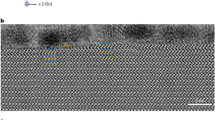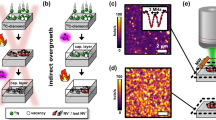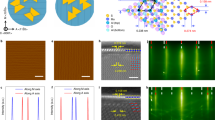Abstract
Thin films of diamond are of interest for technological applications such as hard coatings, heat sinks in electronic devices and miniaturized vacuum diodes1,2,3,4. They are typically produced by chemical vapour deposition, and the presence of atomic hydrogen has been considered crucial for the growth of the diamond crystals5,6,7,8,9. Some studies have claimed diamond film growth in a hydrogen-free environment10,11,12,13, but questions remained about the growth conditions in those cases. Here we report the nucleation and growth of diamond by vapour deposition in a hydrogen-free, pure oxygen environment to form crystals that are heteroepitaxially aligned on a single-crystal sapphire substrate. In other words, we are able to achieve diamond growth under conditions where the oxidative ‘etching’ of carbon must compete with its deposition. By choosing a temperature range that results in preferential oxidation of non-diamond (graphitic) carbon species to that of diamond, we are able to achieve the accumulation of diamond.
This is a preview of subscription content, access via your institution
Access options
Subscribe to this journal
Receive 51 print issues and online access
$199.00 per year
only $3.90 per issue
Buy this article
- Purchase on Springer Link
- Instant access to full article PDF
Prices may be subject to local taxes which are calculated during checkout




Similar content being viewed by others
References
Spitsyn, B. V.et al. Vapor growth of diamond on diamond and other surfaces. J. Cryst. Growth 52, 219–226 (1981).
Kamo, M.et al. Diamond synthesis from gas phase in microwave plasma. J. Cryst. Growth 62, 642–644 (1983).
Bachmann, P. K.et al. Towards a general concept of diamond chemical vapor deposition. Diamond Related Mater. 1, 1–12 (1991).
Okano, K.et al. Low-threshold cold cathodes made of nitrogen-doped chemical-vapor-deposited diamond. Nature 381, 140–141 (1996).
Badziag, P.et al. Nanometre-sized diamonds are more stable than graphite. Nature 343, 244–245 (1990).
Lambrecht, W. R. L.et al. Diamond nucleation by hydrogenation of the edges of graphitic precursors. Nature 364, 607–610 (1993).
Butler, J. E. & Woodin, R. L. Thin film diamond growth mechanism. Phil. Trans. R. Soc. Lond. A 342, 209–224 (1993).
Angus, J. C.et al. Chemical vapor deposition of diamond. Phil. Trans. R. Soc. Lond. A 342, 195–208 (1993).
Bachmann, P. K. in Proc. Int. School Physics “Enrico Fermi” (eds Paoletti, A. & Tucciarone, A.) 45–71 (IOP Press, Amsterdam, (1997).
Eversole, W. G. Synthesis of diamond.US patents 3030187 & 3030188 (1962).
Gruen, D. M.et al. Fullerenes as precursors for diamond film growth without hydrogen or oxygen additions. Appl. Phys. Lett. 64, 1502–1504 (1994).
Mistry, P.et al. Arevolutionary diamond synthesis technique: the QQC materials deposition process. Innov. Mater. Res. 1, 193–207 (1996).
Badzian, A.et al. in Proc. Int. School Physics “Enrico Fermi” (eds Paoletti, A. & Tucciarone, A.) 195–208 (IOP Press, Amsterdam, (1997).
Dijkkamp, D.et al. Preparation of Y-Ba-Cu oxide superconductor thin films using pulsed laser evaporation from high Tc bulk material. Appl. Phys. Lett. 51, 619–621 (1987).
Yoshimoto, M.et al. Room-temperature epitaxial growth of CeO2thin films on Si(111) substrates for fabrication of sharp oxide/silicon interface. Jpn J. Appl. Phys. 34, L688–L690 (1995).
Chen, H.et al. Study of diamond thin-film growth mechanism in a filament-assisted excimer laser ablation system. J. Appl. Phys. 76, 8113–8116 (1994).
Polo, M. C.et al. Pulsed laser deposition of diamond from graphite targets. Appl. Phys. Lett. 67, 2615–2617 (1995).
Yoshimoto, M.et al. Atomic scale control of epitaxial growth and interface in oxide thin films for advanced oxide lattice engineering. Mater. Res. Soc. Proc. 401, 21–30 (1996).
Yoshimoto, M.et al. Atomic-scale formation of ultra-smooth surfaces on sapphire substrates for high-quality thin film fabrication. Appl. Phys. Lett. 67, 2615–2617 (1995).
IIjima, S.et al. Growth of diamond particles in chemical vapor deposition. J. Mater. Res. 6, 1491–1497 (1991).
Tachibana, T.et al. Diamond films heteroepitaxially grown on platinum (111). Phys. Rev. B 56, 15967–15981 (1997).
Rebello, J. H. D.et al. Diamond growth by laser-driven reactions in CO/H2mixtures. Appl. Phys. Lett. 62, 899–901 (1993).
Author information
Authors and Affiliations
Corresponding author
Rights and permissions
About this article
Cite this article
Yoshimoto, M., Yoshida, K., Maruta, H. et al. Epitaxial diamond growth on sapphire in an oxidizing environment. Nature 399, 340–342 (1999). https://doi.org/10.1038/20653
Received:
Accepted:
Issue Date:
DOI: https://doi.org/10.1038/20653
This article is cited by
-
Ultrawide-bandgap semiconductor of carbon-based materials for meta-photonics-heterostructure, lasers, and holographic displays
AAPPS Bulletin (2023)
-
Multi-photon absorption enhancement by dual-wavelength double-pulse laser irradiation for efficient dicing of sapphire wafers
Scientific Reports (2017)
-
Atomic-scale thermal behavior of nanoimprinted 0.3-nm-high step patterns on PMMA polymer sheets
Polymer Journal (2016)
-
RETRACTED ARTICLE: Fundamental Discovery of New Phases and Direct Conversion of Carbon into Diamond and hBN into cBN and Properties
Metallurgical and Materials Transactions A (2016)
-
Sub-nanoscale nanoimprint fabrication of atomically stepped glassy substrates of silicate glass and acryl polymer
Applied Physics A (2015)
Comments
By submitting a comment you agree to abide by our Terms and Community Guidelines. If you find something abusive or that does not comply with our terms or guidelines please flag it as inappropriate.



